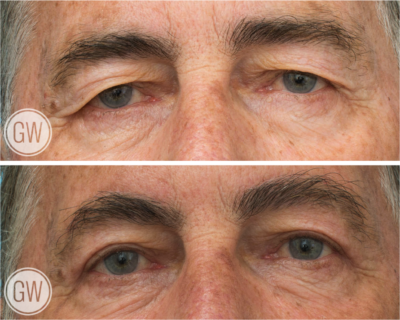
10 Aug Swelling and Bruising after Blepharoplasty
Effective Strategies to Help Reduce Swelling and Bruising After Eyelid Surgery
Blepharoplasty is a popular cosmetic procedure that aims to alter the appearance of the eyes by removing excess skin and fat from the eyelids. As with any surgical procedure, recovery is an important aspect of ensuring optimal results. In this blog, we’ll discuss about the various stages of Upper Eyelid Surgery Recovery day by day, as well as effective strategies to help reduce swelling and bruising, and maintaining the results of the surgery.
Perth Specialist Plastic Surgeon Dr Guy Watts is qualified and experienced in performing Eyelid Surgery. He holds numerous qualifications and memberships that demonstrate his commitment to the field of plastic and reconstructive surgery, as well as his dedication to providing optimal care to his patients.
Stages of Eyelid Surgery Recovery
Days 1-3
During the first few days following your Blepharoplasty, it’s normal to experience some discomfort, swelling, and bruising. You may notice that your eyelids feel tight and tender, and your vision may be slightly blurry. This is all part of the natural healing process.
To manage discomfort, Dr Watts will likely provide you with pain medication. It’s important to follow his instructions carefully to ensure optimal pain relief.
Cold compresses can also help alleviate swelling and bruising during this period. Make sure to keep your head elevated as much as possible to promote proper blood circulation and reduce swelling.
Days 4-7
By the end of the first week, you should begin to notice a gradual decrease in swelling and bruising. Your sutures may be removed around day five, depending on Dr Watts’ recommendations. At this point, you may start to feel more comfortable.
Continue to follow Dr Watts’ post-operative care instructions, such as cleaning the incision sites and applying any prescribed ointments. You may also begin to gently massage your eyelids to promote blood flow and reduce swelling. Make sure to consult with Dr Watts before trying any new techniques or treatments during your recovery.
Days 8-14
During the second week of your Upper Eyelid surgery recovery, the majority of your swelling and bruising should have subsided.
You’ll likely be able to return to work and resume most of your normal daily activities. Make sure to avoid strenuous activities or heavy lifting that could put strain on the healing tissues.
Keep in mind that while you’ll start to see the results of your Blepharoplasty, it can take several weeks or even months for the final outcome to become apparent.
Bruising and Swelling after Eyelid Surgery
Bruising after Eyelid surgery is an expected side effect. The delicate tissues around the eyes are prone to bruising, and the stages of bruising after Blepharoplasty can vary from person to person.
- Stage One (Days 1-3) – During this stage, you’ll likely notice dark purple or blue bruising around the eyes. This is a result of blood pooling under the skin as your body begins the healing process
- Stage Two (Days 4-7) – As your body continues to heal, the bruising will begin to change colour, transitioning from dark purple to a lighter shade of blue or green. This is a sign that your body is breaking down and reabsorbing the pooled blood
- Stage Three (Days 8-14) – By the end of the second week, the majority of the bruising should have faded, leaving behind a yellowish hue. This is the final stage of bruising, and it resolves on its own over time
Tips for Reducing Swelling and Bruising after Blepharoplasty
While bruising and swelling are normal side effects of Eyelid surgery, there are several steps you can take to lessen their severity and duration. Consider the following tips for reducing swelling and bruising after Eyelid surgery:
- Cold Compresses – Applying cold compresses to the eyes for 20 minutes at a time, several times a day, can help reduce both swelling and bruising
- Head Elevation – Keep your head elevated as much as possible during the first few days after surgery, especially while sleeping. This helps to reduce swelling by promoting proper blood circulation
- Avoid Blood-Thinning Medications – Prior to your surgery, Dr Watts will likely advise you to avoid certain medications and supplements that can increase the risk of bleeding and bruising. Be sure to follow his recommendations closely
- Stay Hydrated – Drinking plenty of water can help flush out excess fluids and reduce swelling
- Gentle Massage – With Dr Watts’ permission, you may be able to gently massage the area around your eyes
Strategies For Eyelid Surgery Recovery
In addition to the tips mentioned above there are several other strategies you can employ to aid recovery:
- Follow Dr Watts’ Instructions – Dr Watts will provide you with detailed post-operative care instructions. It’s essential to follow these guidelines closely to reduce the risk of complications and ensure optimal healing
- Rest and Relax – Giving your body the time and energy it needs to heal is crucial. Make sure to get plenty of rest during your recovery, and avoid strenuous activities that could put strain on your healing tissue
- Protect Your Eyes from Sun Exposure – Sun exposure can cause skin discolouration and prolong the healing process. Wear sunglasses, sunscreen and a hat when you are outdoors
- Maintain a Healthy Diet – Eating a well-balanced diet rich in vitamins and minerals can support your body’s healing process
- Stay Patient – Remember that the healing process takes time, and it can be several weeks or even months before your final results are visible
Post-Operative Care After Blepharoplasty
Here are some dos and don’ts of post-operative care:
Do:
- Follow Dr Watts’ instructions closely
- Keep your head elevated, especially during the first few days
- Apply cold compresses
- Clean your incision sites as directed by your surgeon
- Protect your eyes from sun exposure
- Maintain a healthy diet and stay hydrated
- Be patient and give yourself time to heal
Don’t:
- Rub or scratch your eyes
- Wear makeup or contact lenses until cleared by your surgeon
- Engage in strenuous activities or heavy lifting
- Smoke or consume alcohol, as these can hinder the healing process
- Take blood-thinning medications or supplements without Dr Watts’ approval
When to Seek Medical Attention during Recovery after Blepharoplasty
While complications after Upper Eyelid surgery are not common, however it’s important to recognise the signs that may warrant medical attention. Contact Dr Watts’ team immediately if you experience:
- Severe pain that doesn’t improve with prescribed pain medication
- Signs of infection, such as increased redness, swelling, or discharge at the incision site
- Persistent bleeding from the incision site
- Sudden changes in vision, such as double vision, loss of vision, or increased sensitivity to light
- Difficulty breathing or chest pain
FAQs about Eyelid Surgery Recovery
What is the typical recovery time for Eyelid surgery?
- The recovery time for eyelid surgery is different for each patient. In general, most patients can expect to experience swelling and bruising for about one to two weeks following the surgery. During this time, it is common for the eyes to feel tight and slightly uncomfortable.
- It is important to follow the post-operative instructions provided by Dr Watts to ensure optimal recovery.
- It is also advisable to avoid strenuous activities and heavy lifting during the initial recovery period.
How can I manage pain and discomfort during Eyelid surgery recovery?
- Dr Watts will prescribe pain medications to help manage any discomfort you may experience during the initial recovery period. It is essential to take the prescribed medications as directed.
- You can use cold compresses on the eyes to reduce swelling and relieve pain.
- Keeping your head elevated while resting or sleeping can also help alleviate discomfort.
- It is crucial to avoid rubbing or touching your eyes during the recovery process.
Will there be visible scarring after Eyelid surgery?
- Eyelid surgery incisions are made in inconspicuous locations to reduce their visibility.
- The incisions for upper eyelid surgery are typically hidden within the natural creases of the eyelid, while lower eyelid incisions are often made along the lash line or inside the lower eyelid.
- Over time, any residual scars will fade and become less noticeable.
When can I resume normal activities after Eyelid surgery?
- The timeline for resuming normal activities can vary depending on many factors.
- Most patients can return to work and resume light activities within one to two weeks after Eyelid surgery. Keep in mind that it is crucial to avoid strenuous activities, such as heavy lifting and vigorous exercise, for at least three to four weeks.
- Dr Watts will provide specific guidelines based on your unique circumstances to optimise your recovery.
Are there any potential complications or risks associated with Eyelid surgery recovery?
- Eyelid surgery is generally safe, but like any surgical procedure, it carries some risks.
- Potential complications can include infection, bleeding, adverse reactions to anaesthesia, scarring, asymmetry, dry eyes, and temporary or permanent changes in vision.
- If you experience any unusual or concerning symptoms during your recovery, such as severe pain, excessive swelling, or changes in vision, it is important to contact your surgeon promptly. They will be able to evaluate your condition and provide appropriate guidance and care.
Further Reading about Face Procedures with Dr. Watts
- Read Dr Watts’ Brow Lift Surgery Page
- Read Dr Watts’ Eyelid Rejuvenation (Blepharoplasty) Surgery Page
- Read Dr Watts’ Does It Hurt to Get the Blepharoplasty Stitches Removed?
- Read Dr Watts’ Blog about What makes attractive lips?
- Read Dr Watts’ Nasal Reconstruction Surgery Page
Medical References about Eyelid Surgery
- Complications of Blepharoplasty: Prevention and Management – NCBI
- Management of Cosmetic Eyelid Surgery Complications – NCBI
- Blepharoplasty – Mayo Clinic
- Eyelid Surgery (Blepharoplasty) – Cleveland Clinic
Dr. Guy Watts – Specialist Plastic Surgeon In Perth WA
Dr. Guy Watts (AHPRA Medical Reg. MED0001539378) is a Specialist Plastic Surgeon with an extensive career that spans across renowned plastic surgery clinics worldwide. His exceptional expertise has been honed through invaluable experiences at esteemed establishments such as the prestigious New York Eye and Ear Infirmary and the renowned Pitanguy Clinic in Brazil.
Having collaborated with the foremost cosmetic plastic surgeons on a global scale, Dr. Watts has chosen to return to Perth after a remarkable 17-year journey of intensive training and invaluable professional experience to bring the latest practices and technology in cosmetic plastic surgery to his patients.
Dr. Watts is a Fellow of the Royal College of Surgeons (FRACS) and a Member of the Australian Society of Plastic Surgeons (ASPS), Australasian Society of Aesthetic Plastic Surgeons (ASAPS) and the International Society of Aesthetic Plastic Surgeons (ISAPS).







